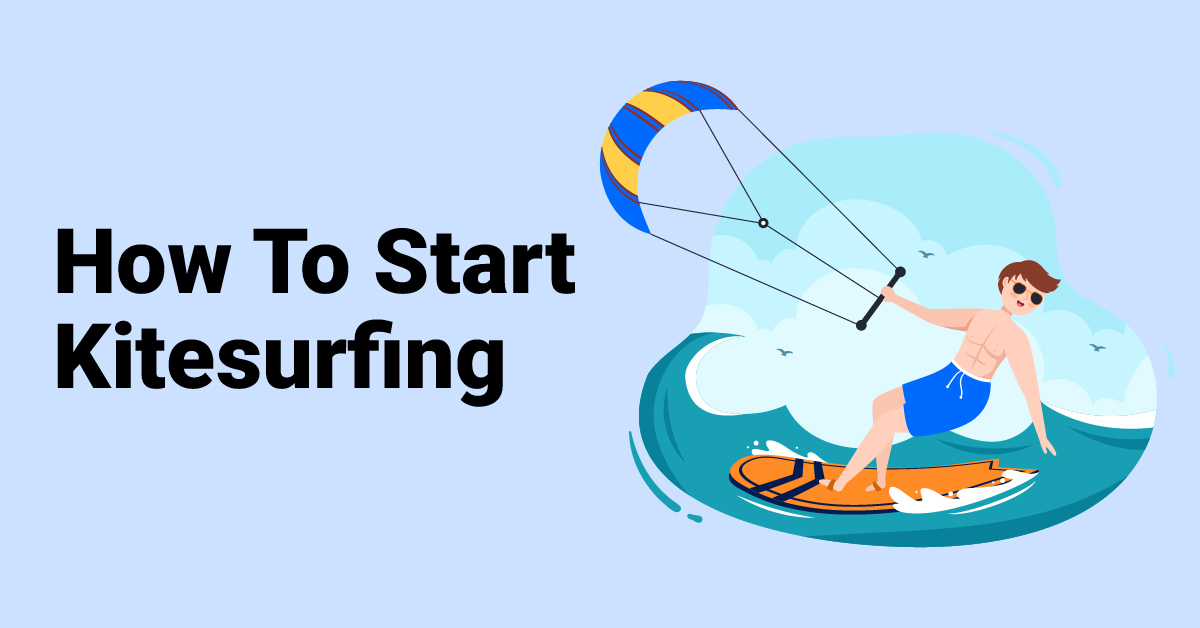This water sport has been taking the world by storm and many people have sought to take it up as a hobby.
This is good seeing as kitesurfing is one of the fastest water sports to learn. That is if you learn it correctly.
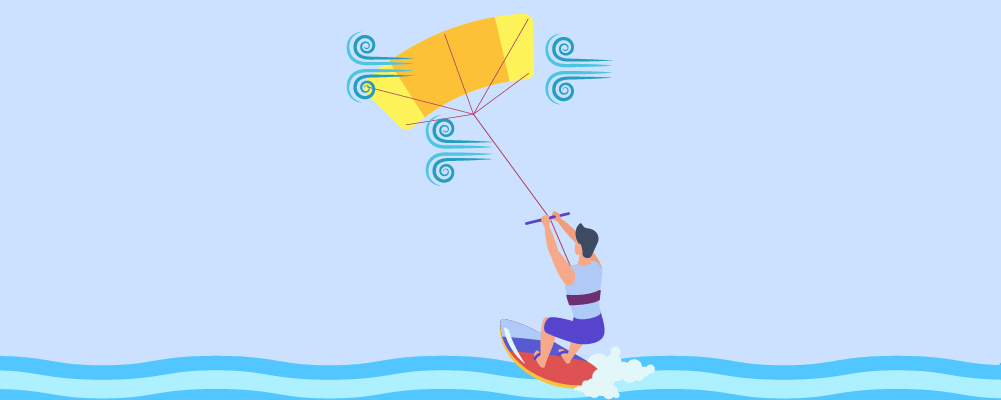
The act of flying across the water with a large kite is something that seems almost fictional. Or at least something that takes a lifetime to learn and can only be done by qualified athletes.
What if we were to tell you that is not the case. Kitesurfing can be learned by anyone, no matter your age or fitness level.
Of course, it will help to have a bit of stamina worked up but you don’t need to be doing 100 push-ups a day.
So, how can you get started? Well, we have curated just the guide for you. Here you will learn all about the first steps to kitesurfing and some pivotal tips to help you on your journey.
Kitesurfing

What Is Kitesurfing
Kitesurfing is a wind-powered water sport. Despite the name, there are no actual waves needed for kitesurfing. That is why you will sometimes see it be called kiteboarding instead.
Aptly, kitesurfing is recognized by the use of a kite and a board. It can take place on calm water and choppy waters, so it can be found on basically any beachfront.
The kite involved isn’t the recognizable hand kite. Instead, it more closely resembles a parachute. This kite can be as small as 0.7 square meters long and can get as large as 21 square meters.
Typically you will see kitesurfing on the ocean, but it can be done on land and snow as well. It is a very versatile sport that deserves its rapidly growing fanbase.
History Of Kitesurfing
While kitesurfing gained a boost in popularity at the turn of the century, it is actually up for debate over who started it. But we have some ideas based on official records.
The first patent for it was filed in 1977 by Dutchman Gijsbertus Adrianus Panhuise.
This patent specifically outlined a water sport that used a board and was being pulled by a wind-catching device that is attached to a harness.
Unfortunately, he found no commercial success in it.
In 1984 the French Legaignoux brothers filed a patent for an inflatable kite, this sparked a relaunch in the concept of kitesurfing.
One of the Legaignoux brothers later launched a design for the ‘bow kite’ which has been licensed to many kite manufacturers.
The first freestyle kitesurfing competition was held in Maui in 2000. This competition was sponsored by Red Bull and helped propel kitesurfing into the mainstream. It is now held annually in Cape Town, South Africa.
Evolution Of Kitesurfing
Since the beginning, kitesurfing has been a rapidly evolving sport. It seems like every year there is an innovation that makes the sport more accessible.
This is especially true in the designs of the kites. As previously stated, in 2006 the second generation of LEI (leading edge inflatable) kites, which included the bow kite, was developed.
These kites allowed for a better relaunch and overall created a safer experience, they were called SLE (supported leading edge) kites.
Before the SLE kites, C-kites were the most popular and still are amongst wake-style kitesurfers. The C-kites are considered better for performance riding, whereas bow kites are for entry-level kiters.
You are now also able to get hybrid kites, these combine parts of the C-kite and bow kites. We bet in the future there will be a new type of kite that will completely change the kitesurfing game.
Since its inception, there has been the creation of many different styles of kitesurfing, some of them are freeriding, foiling, and wakeskate.
How To Get Started

The first thing you need to learn is how to swim. This may seem obvious but you need to be a strong swimmer to combat the waves, so if you are used to doggy-paddling in a pool then you might need to get some practice in before looking into kitesurfing.
Other than knowing how to swim, you need no other skills to get into kitesurfing.
Some attributes that might benefit you are having experience with wakeboarding or windsurfing, but they aren’t necessary as you will eventually learn all the skills you need.
One imperative thing is that you take lessons from a professional. Even for the people who believe they can self-teach themself, it is not worth the risk.
Kitesurfing is a dangerous sport if you don’t know how to properly do it.
No amount of online videos or articles will be able to give you hands-on advice like an instructor can.
A professional will also be able to accurately explain to you the correct safety procedures and techniques so you aren’t sabotaging yourself.
Since you are reading this article, you’re already heading down the right path. Here we can give you the right steps to take before you start your lessons, so you start with a foot in the door.
Remember, as long as you stay motivated you can become a professional kiter in no time at all.
Essential Steps For Beginners
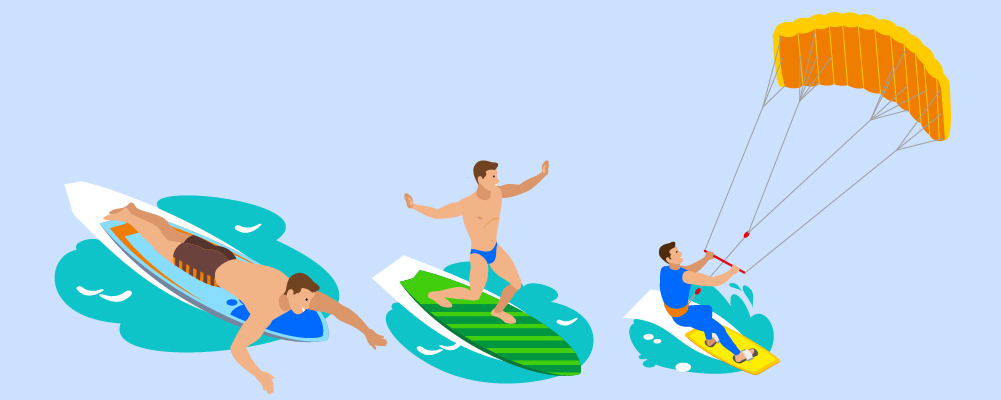
Step 1: Learn How To Fly A Kite On Land And In The Water
Typically you need to learn to walk before you can run. In this case, you need to learn to fly a kite on land before on the water. It is not quite the same thing but the principles still stand.
Remember, kitesurfing doesn’t use hand kites. Instead, they use large inflatable kites. You can buy training kites that are much smaller which will help you learn the basics on how to fly them.
Even if you have flown a kite before, an inflatable kite is a whole other ballpark.
We recommend starting on land first, just pick a nice open field where you can get a good grasp of how to turn it and how to keep it in the air. Once you have understood flying on land, you can move into the water.
This involves just standing in a shallow bit of the ocean and flying your kite. This is beneficial because the winds by the sea are much different from the ones on land.
You must maintain equal tension on the front and back lines of the kite.
The goal of practicing your flying is to understand your wind window. This is the 180-degree arch where your kite flies and the power it provides in each zone.
The edge is where it generates the least power, whereas the middle is where the most power is generated.
Step 2: Get Comfortable With Your Body Being Dragged Through Water
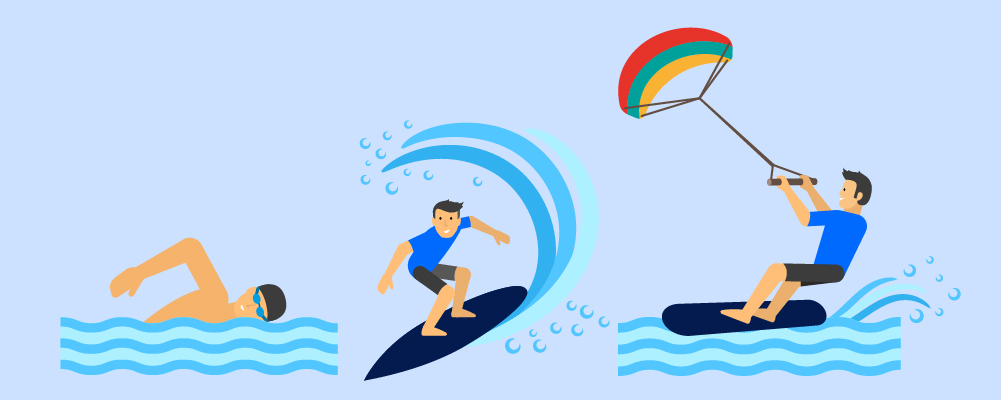
This may seem pointless but trust us when we say it is a key step and is also a lot of fun. Most people’s biggest fear when it comes to kitesurfing is getting dragged through the water via a kite.
This is why it is a good idea to get used to it early on. That way you have no fear holding you back on your way to getting out on the open water.
Not only does this help you overcome a possible fear, but it will also help you learn to control your kite better.
This way you’re controlling your kite with your arms and hips rather than your legs. You will also need to rely on the use of the kite to steer you since you will be dragged.
Similar to the previous step, you must learn to fly your kite in the water without your board. That way you have a better idea of how to control your kite when you get on your board.
This is also the perfect time to learn how to relaunch your kite. This is pivotal to getting out of dangerous situations and it is safer to get used to it when you aren’t on a board.
Step 3: Practice Skateboarding
Now that you have the kite without the board, it’s time to nail the board without the kite.
The quickest way to do that is to brush off the old skateboard. Skateboards teach you the balance and control that you won’t get just by a kite.
There is a sport called kite landboarding where you are essentially kitesurfing, but instead of a board you use a skateboard and the kite is only about 3 square meters. Perfect for those who want to kitesurf but are scared of water.
The goal is to be comfortable on the board and have it as almost second nature. This way you can completely focus on the kite and how it’s moving.
While skateboards are the easiest practice board, you will get the same effect with surfing or snowboarding. They will help you keep your knees bent and keep them loose and flexible so that you can have the most control.
Step 4: Practice Getting Up And Riding A Board
Now that you nailed riding a board and flying a kite, it is time to combine the two. If you have previous experience kitesurfing and are just needing a refresher then you can try this on the water.
However, if you are just starting, then you should practice getting up onto your board on land. You’re able to get an inflatable trainer which is sort of an inflatable bag that will simulate the effect of water.
You can use this to practice standing up straight on your board and your stance while you’re on the board.
Don’t worry if you can’t do it the first time, this is the perfect time to learn when you’re not on the water. You should aim for getting onto your board to be second nature to you.
As for your positioning, you want to make sure you’re watching your footwork. Unlike other water sports, you don’t want your feet to be pointing forward.
You want your feet to be in an almost ‘V’ shape. This means your heels should be closer together than your toes.
Step 5: Take Some Lessons
This step is important, not only will you learn the proper technique but it will make the experience of learning to kitesurf more fun.
This is because you will know you’re doing it right and can progress to the next level quicker.
When choosing your instructor, we recommend talking to previous students of theirs. You want to make sure they know exactly what they are doing but are also friendly and patient.
Most people only need about 12 hours of lessons before they feel confident, but everyone moves at their own pace and you want someone who can support you.
You can choose to do one-on-one lessons, which will give you a more tailored learning experience but they are more expensive.
Or you can have lessons in groups of 2 or more which will be cheaper. Either way, you want to be sure you’re getting quality teaching and possible kitesurfing friends.
When choosing where to take your lessons, we recommend going as local as possible. This will save you money on travel and will overall give you a better learning experience.
You want to learn and get used to the waters you will constantly be kitesurfing on. Not all of us are blessed with a local beach that has consistently calm waters.
The kitesurfing instructor will provide you with the right equipment, so you won’t be wasting money on gear that will eventually break when you’re learning how to use it.
It will also give you an idea of the kit you will need to buy when you eventually get your own.
You should only stop having lessons and start kitesurfing independently when you have been signed off by an instructor.
Not only is it their choice when you’re ready, but it is also your own. You don’t want to be out there without constant support until you are 100% ready.
Step 6: Only Purchase Gear That Is Suitable For Your Level
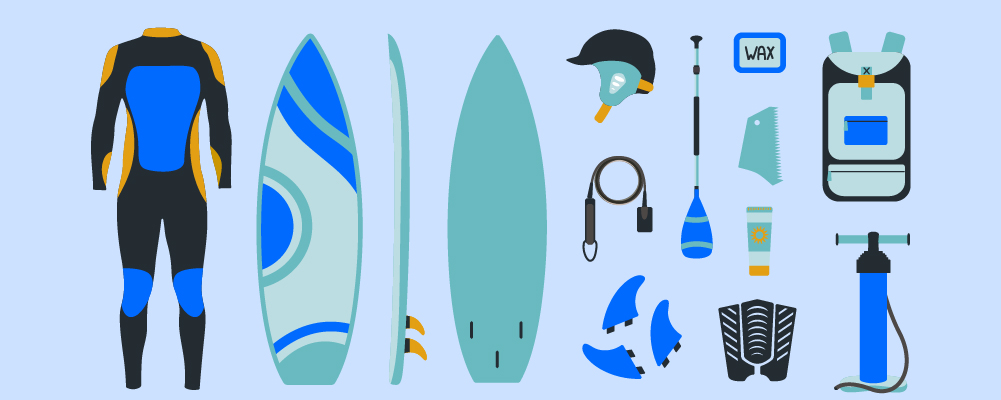
After completing your lessons, the next step is to buy your kit. This typically includes:
- Wetsuit – You can get away with just a well-fitting swimsuit but in the colder seasons you will want something warmer.
- Kite – The thing that gave the sport its name. You can get many different kites for each circumstance.
- Board – The most common type of board is the twin tip. This allows you to go in any direction without switching your feet.
- Bar and lines – These are what allow you to control your kite. Like kites, you can get them in different sizes to suit your needs.
- Seat or waist strap – Seat harnesses are easy to learn on, but you may quickly outgrow them. This is because waist straps allow for more movement.
- Safety leash – This connects your harness to your line system. It also has a safety release if you need to completely eject yourself from your kite.
- Safety knife – Hopefully you will never need to use it, but it is important to keep it on your person. This knife is typically stored in your harness for easy access.
- Flotation vest – This needs to be specific for kitesurfing since you still need a good range of motion.
- Helmet – This also needs to be specific for kitesurfing. They are more rounded and will protect your head from water impact.
While you can save money and can buy your kit used, it is recommended that you always buy your kite and bar new.
This is because they are the most important parts in keeping you safe, so you want to make sure they are in the best possible condition.
When shopping around, you may see there is a lot of variety when it comes to each part of the kit. That is because kitesurfing is a very inclusive sport, so there are different kits based on your skill level and size.
For beginners, it is generally considered a good idea to start with a large board and a small kite. This is because it gives you more control and less power.
Step 7: Enjoy Yourself!
This is the most important step. No matter how good you are, if you aren’t enjoying yourself then you aren’t kitesurfing.
While kitesurfing has a steep learning curve in the beginning if you take your time and stay motivated, you will be doing tricks in no time.
Once you’re independent on the water, you can start taking your skills around the globe. Kitesurfing is a great excuse to see the world, it allows you to see the hidden treasures of a country and create memories that will last a lifetime.
Helpful Tips
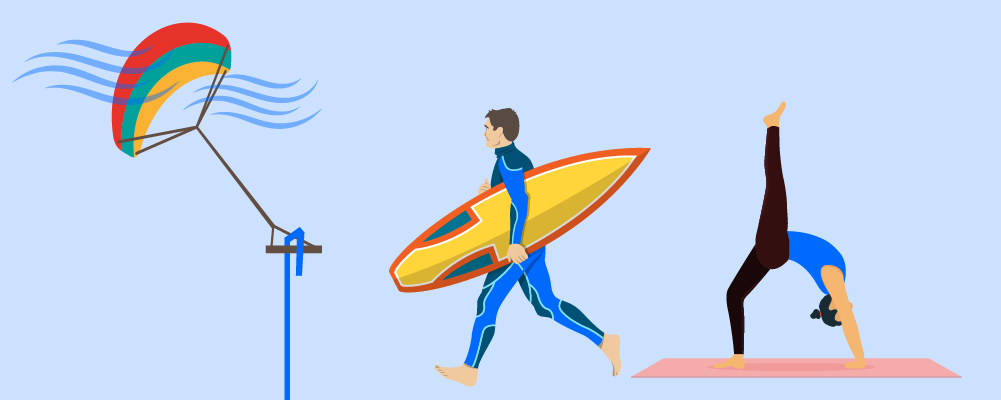
Understand Wind Directions
Wind directions are arguably the main factor in determining which direction you’re going in. The ideal wind direction is either cross-shore or cross-onshore.
These make sure you’re not being blown directly back onto land, and also that you don’t accidentally go too far out.
The strength of the wind also determines what kite you will need. Stronger winds require a smaller kite so that it is still easy to control.
The easiest way to determine the conditions of the wind is to use the Beaufort wind force scale. This describes the wind in knots and what you can expect it to feel like.
Assess A Suitable Location
Not only do you want to choose a beautiful location, but you want it to be safe. This means the ocean is clear of debris and rocks and doesn’t have anyone you can crash into.
This could include people doing other water sports which are too fast to predict, people who are swimming out farther than usual, or a very packed beach.
The downside of having an overly-crowded beach is that there is nowhere for you to safely set up your equipment.
Understand Tides, Currents, And Hazards
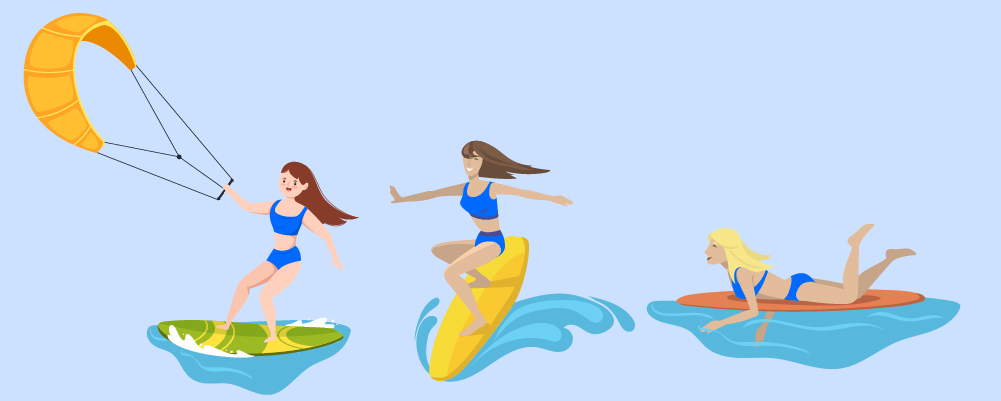
Unpredictability isn’t your friend, whenever you go out kitesurfing you need to be aware of everything that can happen.
When it comes to tides and currents, most of them won’t be an issue for you. You will need to understand when high and low tide is and if there are any extreme currents.
High tide can make your launching point and landing zone too close to hazards, and low tide can expose sealife which usually won’t be in the way.
Extreme currents can drag you to areas you are not expecting to go so you need to be aware of them. Rip tides are a form of currents that can be lethal if you’re not expecting it, it is estimated that a total of 150 rip-tide-related fatalities happen each year on US beaches.
If you feel like the weather is too much for you to handle (extreme rain, strong winds, etc) then don’t go out in it.
If you want to challenge yourself then build up to that weather instead of diving straight into it. If you are unprepared then it can cause you serious injury.
One hazard that many people don’t immediately think of when thinking about kitesurfing, is marine life. This is because people assume that because you are above the water, you won’t be coming into contact with them.
This is not true. Even the most professional kitesurfers end up in the water. You need to be aware of what the local marine life is and how they interact with humans.
The speed of your board can disturb a lot of wildlife, this can include sharks, jellyfish, and even crocodiles depending on where you’re kitesurfing.
Get The Right Equipment
Once again, we cannot stress enough the importance of proper safety equipment. Even if you have seen someone kitesurfing in just a swimsuit, that doesn’t mean you should take the risk.
You need up-to-code equipment like a kite and board, and the proper flotation devices.
Kitesurfing schools will provide most of the equipment for you. The only thing you may need to bring is a wetsuit. This allows you to try out kitesurfing without putting in a large investment into the right kit.
As previously stated, the right equipment may change depending on the weather and season. If you ever get stuck then you can ask any kitesurfing shop what you need, they are there to help you determine what you need for your skill level and build.
Extra equipment that you may want includes a rash guard, waterproof sunscreen, and sunglasses.
Make sure your sunglasses won’t slip off, the worst thing is losing your favorite pair to the bottom of the ocean.
One important thing to note is that you DO NOT use a board leash. While these are great for helping surfers retrieve their boards, for kitesurfers it can be dangerous to use one.
This is because the kite is controlling you rather than the board. This means that if you lose your board then the leash can cause it to fly back and hit you.
When you need to retrieve your board after losing it, you should practice upwind body dragging. This is where you use your kite to drag your body to where your board is, you should be used to this because you practiced step 2 of our essential steps for beginners.
Practice Safety Procedures
It is important when kitesurfing to always have a way to call for help. This can be through always carrying your phone, or having a tracker or beacon.
You want to make sure that any equipment you are using is properly functioning. If you are using your phone ensure it is in a waterproof pouch, is properly charged, and either has service or an SOS feature.
The next thing is to properly practice getting dragged through the water. This is your main technique for when you have lost your board or need to get out of a hazardous spot.
While keeping yourself safe is important, you also need to ensure the safety of others around you. This includes getting out of the water safely so you’re not accidentally running into beach-goers.
The most common injuries happen close to or on the beach. So if you feel like you can be lax in your safety procedures on the beach, you need to be extra diligent instead.
Practice Your Riding
Practice makes perfect, even though you will be having so much fun it doesn’t feel like practice. You can practice your riding in the water, or on land if you feel more comfortable.
The goal is to not have to think about your board while kitesurfing. You want your board to be almost an extension of your feet with the way you use it.
Speaking of feet, the distance between them on the board is something that can greatly impact your riding.
Unlike other sports, there is no set distance with how far apart your feet should be, although most people opt for about shoulder length apart. Why not try different distances on land until you find your sweet spot.
Practice Your Control
You never want to be out of control when kitesurfing. That could lead to injuring yourself and/or others. It is estimated that for every 1,000 hours of kitesurfing you can expect 5.9-7.0 injuries.
You want this number to be as low as possible and the best way to do that is with accurate control.
Just like a bike, your bar is the main way you control your kite. You want to find a sweet spot on it where you’re feeling the most in control.
The bar is not only controlled by your arms but also your hips. The best method to do this is to keep your hips bent as close to the bar as they can get.
While your arms and hips do a lot of the movement, you need to learn how your strap moves the bar.
The strap doesn’t automatically depower your kite. Instead, it moves the bar making it easier to get back into its sweet spot.
Practice Speed
Once you get the basics down you can start speeding up. While there is no set trick to speeding up, you will naturally do it as you progress on your kitesurfing journey.
As long as you stay in control and accurately follow the wind then you will be reaching top speeds in no time.
We previously mentioned the wind window, understanding this is how you can determine your speeds. The more power behind your kite, the faster you will go.
This is why having your kite low in front of you will build up the most speed.
Not only is practicing your speed about going faster, but you also need to learn when it is appropriate to slow down. This could be because of an obstacle or because you’re preparing to dismount.
Know The Rules Of The Water
Ultimately, you want good sportsmanship. Kitesurfers are a friendly group of people but that is because they have respect for each other.
The best way to understand what the conditions of the water are like is to simply ask your fellow kiters.
There are of course some general rules that each kitesurfer follows so that way everyone has a good time out on the water.
One of the rules is that riders coming out from the beach, have priority over riders going into the beach.
Another is that to avoid having tangled kite strings, you should keep your kite high if you are riding upwind, whereas downwind riders should keep their kite low.
Kites are also considered sailing tools, so any standard sailing rules apply to them as well.
Summary

Now you have all this information, it is time to get out there and practically apply it.
The overall top tips to follow for when you go out kitesurfing are:
- Go with a friend – It is more fun to share this experience with a friend and you can help each other if anything unexpected happens.
- Never ride out further than you can swim – You should always be aware of how far away you are from land and if you’re able to reach it if need be.
- You’re never done learning – No matter how long you have been kitesurfing, there is always something else to learn as the sport evolves. This is one of the many reasons why kitesurfing is so addicting, you never know what the future holds for it.
Have fun and we will see you on the water!

